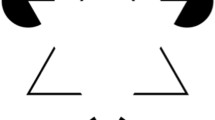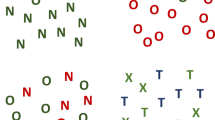Abstract
SUBJECTIVE figures, seen in the absence of luminance gradients (Fig. 1), provide a phenomenal illusion that can be related to the properties of single cells in the visual cortex1, offering a rare bridge between brain function and visual awareness. It remains controversial whether subjective figures arise from intelligent cognitive mechanisms2–4, or from lower-level processes in early vision5,6. The cognitive account implies that the perception of subjective figures may require serial attentive processing, whereas on the low-level account they should arise in parallel at earlier visual stages. Physiological evidence apparently fits a low-level account7,8 and indicates that some types of subjective contour may be detected earlier than the conventional Kanizsa9 type. Here we report that even Kanizsa subjective figures can be detected without focal attention at parallel stages of the human visual system.
Similar content being viewed by others
References
Peterhans, E. & von der Heydt, R. Trends Neurosci. 14, 112–119 (1991).
Gregory, R. L. Nature 238, 51–52 (1972).
Coren, S. Psych. Rev. 79, 359–367 (1972).
Rock, I. & Anson, R. Perception 8, 665–681 (1979).
Brigner, W. L. & Gallagher, M. B. Percep. Motor Skills 38, 1047–1053 (1974).
Smith, A. T. & Over, R. Nature 257, 581–582 (1977).
Grosof, D. H., Shapley, R. M. & Hawken, M. J. Nature 365, 550–552 (1993).
von der Heydt, R., Peterhans, E. & Baumgarter, G. Science 224, 1260–1262 (1984).
Kanizsa, G. Rivista di Psicologia 49, 7–30 (1955).
Gurnsey, R., Humphrey, G. K. & Kapitan, P. Percep. Psychophys. 52, 263–276 (1992).
Grabowecky, M. & Treisman, A. Invest. Ophth. Vis. Sci: suppl. 30, 457 (1989).
Duncan, J. & Humphreys, G. W. Psych. Rev. 96, 433–458 (1989).
Treisman, A. M. & Gelade, G. Cog. Psych. 12, 97–136 (1980).
Enns, J. T. & Rensink, R. A. Science 247, 721–723 (1990).
Townsend, J. T. Percep. Psychophys. 10, 161–163 (1971).
Broadbent, D. E. in Modelling Cognition (ed. Morris, P.) 169–186 (Wiley, London, 1985).
Ginsburg, A. P. Nature 257, 219–220 (1975).
Pradzny, K. Percep. Psychophys. 34, 403–404 (1983).
De Valois, R. L. & De Valois, K. K. Spatial Vision (Oxford Univ. Press, Oxford, 1990).
Ginsburg, A. P. in The Perception of Illusory Contours (eds Petry, S. & Meyer, G. E.) 126–130 (Springer, New York, 1987).
Ramachandran, V. L. in The Perception of Illusory Contours (eds Petry, S. & Meyer, G. E.) 93–108 (Springer, New York, 1987).
Enns, J. T., Ochs, E. P. & Rensink, R, A. Behavior Research Instruments & Computers 22, 118–122 (1990).
Warm, J. S., Dember, W. N., Padich, R. A., Beckner, J. & Jones, S. Percep. Psychophys. 39, 219 (1986).
Author information
Authors and Affiliations
Rights and permissions
About this article
Cite this article
Davis, G., Driver, J. Parallel detection of Kanizsa subjective figures in the human visual system. Nature 371, 791–793 (1994). https://doi.org/10.1038/371791a0
Received:
Accepted:
Issue Date:
DOI: https://doi.org/10.1038/371791a0
- Springer Nature Limited
This article is cited by
-
Awareness-independent gradual spread of object-based attention
Current Psychology (2023)
-
Interocular Grouping in Perceptual Rivalry Localized with fMRI
Brain Topography (2021)
-
Attentional selection and illusory surface appearance
Scientific Reports (2019)
-
Gestalt grouping cues can improve filtering performance in visual working memory
Psychological Research (2019)
-
Attentional modulations of the early and later stages of the neural processing of visual completion
Scientific Reports (2015)





